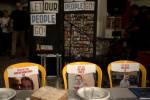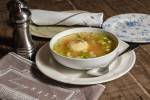Garden-style holiday wreaths
During the half-dozen years that she served as the chief floral designer at the White House during the Obama administration, Laura Dowling and her staff crafted countless wreaths.
“I created wreaths for holiday decor, to commemorate presidential birthdays and to honor fallen heroes. … In my White House work, I saw how the simple wreath form conveyed tradition, meaning and metaphor, representing so much more than a simple decorative placement,” she wrote in her book “Wreaths: With How-to Tutorials” (Stichting Kunstboak, $35), due out Nov. 30.
During the holiday season, dozens of wreaths adorn the White House grounds. They hang on perimeter gates, the north and south porticos and the Truman balcony.
Wreaths also play a festive role indoors at 1600 Pennsylvania Ave.
“I always felt like it was important to draw people in and use wreaths on the windows,” Dowling said. “Each year, we would do something fun and unique. It was kind of like an art gallery.
“One year, we used fruits and vegetables … to create these oversized, geometric wreaths — diamond-shaped, squares, round, oval — made out of gourds and dried (seed) pods and things that were very colorful but also very striking. I think each wreath had about 800 individual elements that were wired into it.”
Prior to landing the White House job in 2009, Dowling, who holds degrees in political science and public policy, worked for The Nature Conservancy, an Arlington, Virginia-based environmental nonprofit organization that protects land and water around the globe. She went on to study the floral arts at L’Ecole des Fleurs in Paris.
Following her 2015 departure from the White House, she penned a pair of books, “Floral Diplomacy: At the White House” and “A White House Christmas: Including Floral Design Tutorials,” which were published last year.
“It seemed kind of a natural progression to go from ‘A White House Christmas’ … to something that kind of delves more deeply into wreaths and the design of it,” she said.
Brimming with colorful photos, her latest tome features detailed instructions for making elegant wreaths largely from fresh flowers, produce and other organic materials, as well as various “unexpected” items including folded paper and even marshmallows.
“You can use simple materials,” she said. “I’m really trying to encourage people to be creative and innovative and use things that are on hand.”
The finished products can adorn not only doors and windows but also chair backs, gates, walls and other spaces year-round.
Dowling resides in the Old Town neighborhood of Alexandria, Virginia, where colonial history and traditions are alive and well, she said, and “making natural wreaths is still very much en vogue.”
She calls wreaths “the jewelry on the door. It’s really almost the most important thing, I think, for holiday decorating. Even if you don’t have time … to (decorate) an entire house, it’s usually pretty accessible to put a wreath on the front door.”
During the fall and winter holidays, “people traditionally view them as a static thing,” Dowling said. “You buy a wreath, you keep it up maybe for a month or two. … I think when you’re using fresh materials, it’s important to kind of look at them as a temporary thing.”
In the introduction of “Wreaths,” she wrote, “Of all the floral art forms in the language of flowers, the wreath is arguably the most powerfully symbolic. With no beginning and no end to its circular form, the wreath represents eternity and immortality — and, according to some, is the ultimate symbol of achievement and success.”
Despite that inherent symbolism, Dowling contends that wreaths are in need of “a major overhaul and upgrade.”
Viewing examples online and at craft stores, “you kind of see the same old thing,” she said. “To me, the ready-made, commercial wreaths are a little bit flat, one-dimensional, maybe using expected materials.”
With the wreath form, “there’s such an opportunity to introduce a personal style and create a theme, maybe even add a little bit of whimsy to the work.”
In the book, Dowling compares the wreath-making process to “telling a story with a beginning, a middle and an end. It requires a compelling plot (theme), a mix of interesting characters (design elements) and a strong narrative (technique) that builds up with a crescendo and flourish to a dramatic ending (finishing touches).”
Swan Lake, a wintery wreath included in a chapter titled “From the Woods,” features bunches of silver-painted eucalyptus pods and ruscus stems, white tree branches, feathers, silver wrapping paper and medium-sized marshmallows.
“For this classic winter-wonderland idea, I wanted to use white-on-white with a lot of different textures and layers,” Dowling explained.
A holiday-wreath staple, pine cones are the basis for several projects highlighted in the book.
“I think using them natural is great, but if you want to add some color or style,” Dowling suggests gilding them with silver or gold spray paint.
Rose hips, berried green ivy and stems of bright orange “pumpkin trees” are the components of a wreath dubbed Pumpkin Patch.
“You can get those at the grocery store,” she said of the pint-sized fruits, which are actually a variety of ornamental eggplant that grows on stalks. With craft wire and wooden picks, she affixed them to an 18-inch grapevine wreath form and created a fanciful fall display.
Connie Jo Harris is a fan of incorporating fresh materials with “permanent botanicals” (more commonly known as silk plants) in wreaths.
A longtime instructor with the College of Southern Nevada’s floral design technology program, Harris is an accredited member of the American Institute of Floral Designers.
She noted that even during the cooler fall and winter months, the Southern Nevada sun “is going to beat down on the fruits” and vegetables.
“Something with a harder skin, like an orange or a pomegranate,” may be suitable for an outdoor wreath, she said. “You can get some really nice dried quince. That looks really beautiful.”
Harris, a certified floral designer, also suggests adding succulents to designs.
“They are really big in the floral industry right now. … If you can get some really good-looking faux succulents, put them in there along with some fruit.”
When designing and decorating with wreaths, she said, “pick a theme and stick with it throughout your house, because (it is displayed on) the entrance to your home.






























